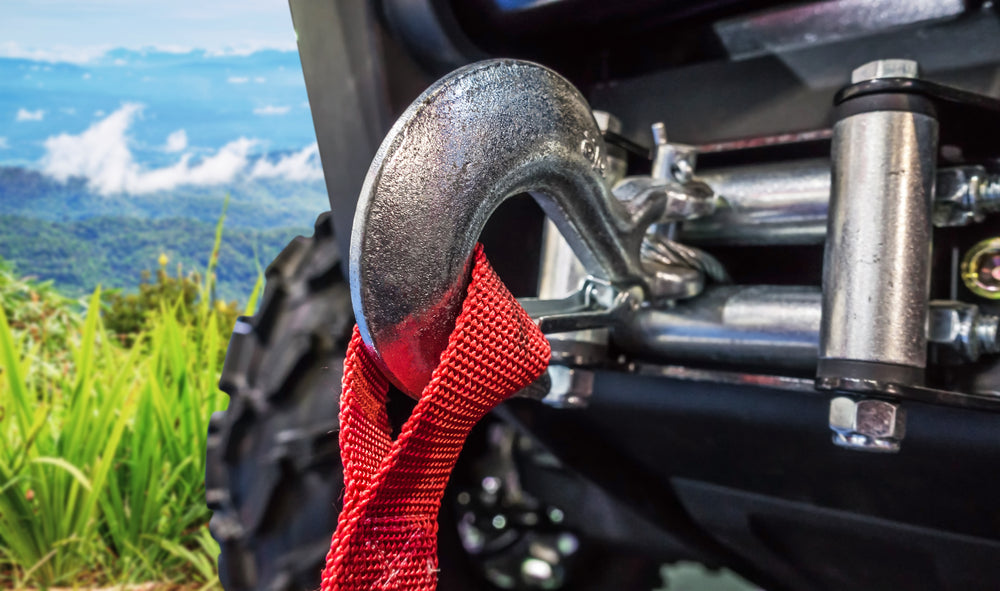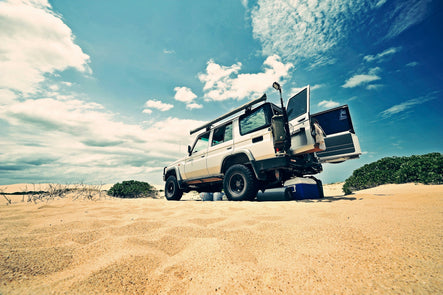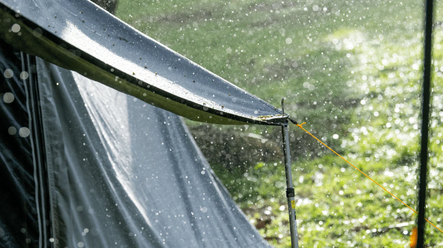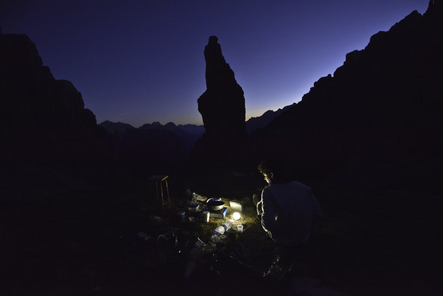While off-roading is a great way to explore the great outdoors, it also presents its fair share of challenges. To stay safe and on track, the following factors are non-negotiable: proper preparation, research, and quality 4WD recovery gear. Whether you're new to off-roading or a seasoned veteran, understanding how to safely use these tools is the difference between a good adventure and a great one.
4WD recovery gear serves a multitude of purposes, each designed to assist you in a different off-road scenario. Tow straps, for instance, are used to pull a vehicle out of a stuck position using another vehicle. Hi-lift jacks are versatile tools that can lift, winch, clamp, and push, while recovery straps—designed to stretch under load for maximum performance—are used for snatching out-stuck vehicles. Shackles serve as a link to connect the looped ends of cables, straps, and snatch blocks.
In this introductory guide to 4WD recovery gear, we'll walk you through what you need to stay safe and on track.
Understanding 4WD Recovery Gear
Before we dive into the details, let's start with the basics. 4WD recovery gear consists of a variety of tools and equipment. Designed to help you recover your vehicle, there’s no need to worry if you’re stuck in challenging off-road situations.
The most likely problem is becoming stuck in deep mud, sand, or other precarious spots. Without the right gear, getting yourself unstuck can be almost impossible, and you'll be forced to contact a towing company for help.
Here's a quick overview of some common types of recovery gear and their purposes:
-
Tow Straps: Tow straps are heavy-duty straps designed to help pull a stuck vehicle out of a predicament. They are typically made of nylon or polyester and can handle a significant amount of tension.
-
Hi-Lift Jacks: Hi-lift jacks are versatile tools that can be used for lifting, winching, clamping, and spreading. They're especially handy for changing tires or lifting your vehicle out of a rut.
-
Recovery Straps: Recovery straps are different from tow straps. They're stretchy and are designed to store kinetic energy, allowing for a more controlled and gentle pull when recovering a stuck vehicle.
-
Shackles: Shackles are used to connect straps, cables, or winch lines to anchor points on your vehicle. They come in various shapes, sizes, and are an essential part of the recovery process.
-
Winches: Winches are motorised devices that pull your vehicle out of a tough spot. They're often mounted on the front of 4WD vehicles and can be a game-changer when you're stuck.
Now that we've got the basics down, let's explore some essential tips to ensure a safe 4x4 recovery.
10 Tips for a Safe 4x4 Recovery
First things first: always prioritise safety. Make sure everyone is a safe distance away from the recovery operation, and no one is standing in the potential path of the recovery gear. With that in mind, here are ten tips for a safe and effective 4WD recovery.
1. Know Your Gear
Familiarise yourself with the specific recovery gear you own. Understand its limitations, load capacities, and proper usage.
2. Use Suitable Anchor Points
Attach recovery gear to sturdy anchor points on your vehicle, like tow hooks or recovery points. Avoid using fragile parts like bumpers or axles.
3. Communicate Effectively
Clear communication is crucial. Use hand signals or radios to coordinate with others involved in the recovery operation.
4. Avoid Sharp Angles
Try to keep recovery straps or winch lines as straight as possible. Sharp angles can increase the risk of equipment failure or injury.
5. Keep It Taut
Ensure the recovery strap or cable is under tension before attempting to recover the vehicle. Slack can lead to sudden jerks and accidents.
6. Monitor Load
Keep an eye on the load you're applying during recovery. Excessive force can damage your vehicle or recovery gear.
7. Use Dampeners
When using recovery straps or winches, attach a dampener (a heavy bag or blanket) to absorb energy and reduce the risk of equipment snapping.
8. Stay Clear
Once the recovery operation begins, stay clear of the equipment and vehicles involved. Never attempt to adjust or intervene while the gear is under tension.
9. Beware of Snapping
Be cautious when using kinetic recovery straps. If they snap, they can cause severe injuries. Always follow manufacturer guidelines.
10. Seek Professional Help
If you're uncertain about a recovery operation's safety, it's best to call in a professional tow truck or recovery service. Better yet, before you hit the road, hit up Camping Adventures for expert advice on recovery gear, or feel free to explore a range of 4WD camping accessories in Melbourne.
Now that we've covered some safety tips, let's focus on two crucial components of 4WD recovery gear: recovery straps and recovery kits.
Get to Know Your Recovery Straps
Recovery straps are an essential tool for safely recovering a stuck vehicle. They come in different types, including snatch straps and winch extension straps. Here's what you need to know:
-
Snatch Straps: Snatch straps are designed to stretch and store kinetic energy, providing a smoother and more controlled recovery. They are perfect for getting a stuck vehicle out of sand, mud, or snow.
-
Winch Extension Straps: These non-stretch straps are primarily used to extend the reach of your winch cable when the anchor point is further away.
When selecting a recovery strap, consider factors like weight capacity, length, and material. It's essential to choose a strap that matches your vehicle's weight and the type of terrain you'll be tackling.
The Importance of Recovery Kits
It is possible to go bush without a recovery kit, although it is not recommended. A well-equipped recovery kit can make all the difference when you're in a challenging off-road situation. A typical recovery kit should contain the following components:
-
Snatch Block: A snatch block can double the pulling power of your winch by changing the direction of the cable.
-
Gloves: Heavy-duty gloves are essential for hand protection when handling recovery gear.
-
D-Shackles: D-shackles are used to connect straps or cables to anchor points safely.
-
Recovery Tracks: These are designed to provide traction for your tires when stuck in mud, sand, or snow.
-
Tire Deflators: These tools allow you to quickly and accurately deflate your tires for better traction.
-
Shovel: A compact shovel can be a lifesaver when you need to clear debris or dig your vehicle out.
-
Air Compressor: An air compressor can reinflate your tires after using tire deflators.
-
First Aid Kit: Safety should always come first. A basic first aid kit is a must-have in case of emergencies.
-
Flashlight: Adequate lighting is crucial, especially during nighttime recoveries.
Safest Method for Recovering a Vehicle
Now that you have the right gear and know how to use it, let's discuss the best practice methods for safe recovery:
-
Assess the Situation: Before you start the recovery operation, evaluate the terrain and the condition of your vehicle. Make a plan and communicate it to everyone involved.
-
Use a Spotter: Having a spotter on the ground who can provide guidance and ensure everyone's safety is invaluable.
-
Slow and Steady: Perform recovery operations slowly and steadily. Avoid sudden jerks or aggressive manoeuvres that could cause accidents.
-
Double-Check Connections: Before applying any force, double-check all connections and attachments to ensure they are secure.
-
Stay Calm: Keep a cool head and stay calm during the recovery. Panic can lead to poor decision-making and increased risks.
The Importance of Maintenance
Proper maintenance of your 4WD recovery gear is vital for its longevity and effectiveness. Here are some maintenance tips:
-
Regular Inspection: Routinely inspect your gear for signs of wear, fraying, or damage. Replace any compromised components immediately.
-
Clean and Lubricate: Clean your gear after each use to remove dirt and debris. Lubricate moving parts as per the manufacturer's recommendations.
-
Store Properly: Store your recovery gear in a cool, dry place away from direct sunlight and moisture.
-
Follow Manufacturer Instructions: Always follow the manufacturer's maintenance guidelines for your specific gear.
Investing in Quality Gear
When it comes to 4x4 camping, safety is non-negotiable. That's why investing in top-notch 4x4 camping accessories—especially recovery gear—is an absolute must. This gear is designed to take on the tough challenges you might encounter while off-roading, giving you peace of mind and keeping your fellow adventurers safe.
But it's not just about safety; it's also about the whole camping experience. Quality accessories can make setting up camp, exploring rugged terrain, and handling unexpected obstacles a breeze. So, for your next outdoor adventure, choose gear that's not only reliable, but guarantees a fantastic and secure journey.
Don't cut corners when it comes to your safety and the safety of your fellow off-roaders. Investing in quality recovery gear is essential.
Here's why:
-
Reliability: Quality gear is less likely to fail during critical recovery operations, reducing the risk of accidents.
-
Durability: Quality gear lasts longer and can withstand the rigours of off-roading, saving you money in the long run.
-
Peace of Mind: Knowing you have reliable gear on hand can boost your confidence when exploring challenging terrains.
Camping Adventures is home to 4WD camping accessories, 4WD tray installation, and more. Come and visit our indoor showroom where you can see our quality range of 4x4 and RV accessories on display and in person. Booking a viewing, demonstration, and being at the showroom gives you the opportunity to become familiar with the products and ask any questions you may have.
Frequently Asked Questions About 4WD Recovery Equipment
Now, let's address some frequently asked questions about 4WD recovery gear:
Q1: Can I use a regular tow strap for recovery operations?
A1: While regular tow straps are strong, they are not designed to store kinetic energy like recovery straps. It's safer to invest in dedicated recovery gear.
Q2: What's the difference between a snatch strap and a winch extension strap?
A2: Snatch straps stretch to provide controlled recovery, while winch extension straps are non-stretch and primarily used to extend the reach of your winch cable.
Q3: How often should I inspect and maintain my recovery gear?
A3: Perform a visual inspection before every use and conduct a more thorough inspection after significant recoveries or every few months. Maintenance should be done as per the manufacturer's guidelines.
Q4: Can I use recovery gear on a public road?
A4: Recovery gear is intended for off-road use. Using it on public roads may be illegal and unsafe.
A Final Word on 4WD Recovery Gear
In the exhilarating world of 4WD off-roading, preparation and safety should always come first. Understanding your 4WD recovery gear, following safety tips, and investing in quality equipment is key to enjoying a trouble-free off-roading experience.
Remember that off-roading can be unpredictable, so continuous learning and preparation are your best allies. Stay safe and have fun exploring the great outdoors! For further resources, check out the links below:
- Why You Should Choose a TJM Bull Bar for Your 4WD
- The Best 4x4 Tracks in Victoria for Beginners
- Pros and Cons of Installing a Bull Bar for Your 4WD
Happy off-roading!
Oz Camping Adventures: Melbourne's Destination for 4WD Camping Accessories
At Camping Adventures, we're 4WD enthusiasts ourselves. We extend a warm invitation to visit our indoor showroom, where you can discover our extensive range of 4WD recovery gear and 4WD accessories. Here, you can experience the exceptional quality and diverse selection of our products up close.







